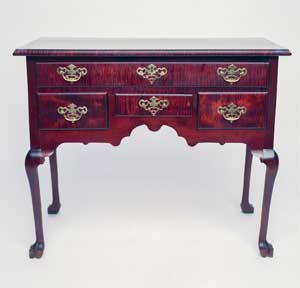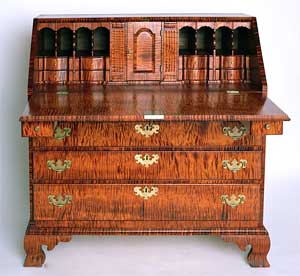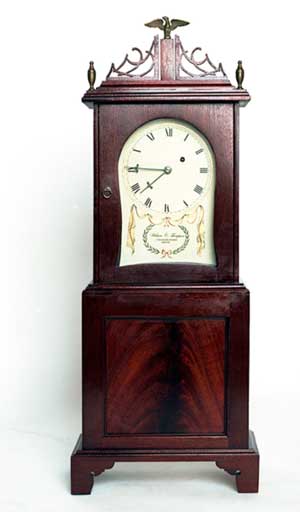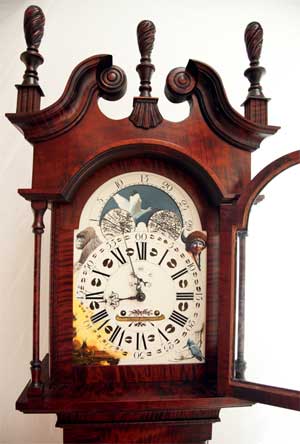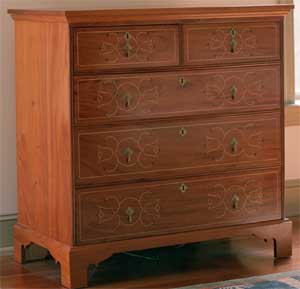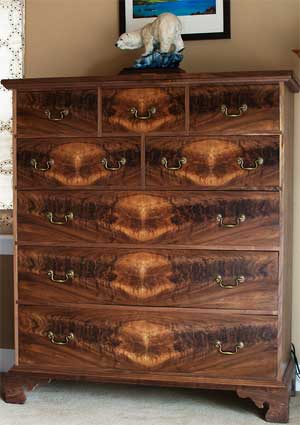
Bill Thompson took shop class in high school — taking advantage of a teachers’ strike that had classes letting out at 11 a.m. to seize extra time in the woodshop — but, after that experience in the late 1960s, “I never did it again until 12 years ago.”
What happened then was that Bill’s house was under construction. “I watched the guys putting up trim, and I thought I’d like to get back into the hobby.”
He bought a table saw and a router and, since he liked the way the trim looked, he incorporated fluted columns onto his first project, a pedestal. “I thought if I could make a pedestal, I could put a piece of art on it. Then I bought a book on boxes. I look at them occasionally, and it’s kind of a joke: I didn’t know what I was doing.”
Eventually, at a woodworking show, he purchased a Glen Huey CD on building a small chest. “I watched it over and over before I went into the woodshop, then I would do it exactly as he said to do it. I hand cut dovetails and made runners, and it got me interested in making fine furniture.”
He followed that up by taking some classes in Pottstown, Pennsylvania, from 18th century furniture specialist Chuck Bender. In one of the classes, Bill made a Chippendale desk; since then, he’s made other items in the 18th century style, such as a grandfather clock and spice boxes.
“To me, with the newer stuff vs. the older stuff, the older stuff is beautiful,” Bill said. “I really like that they made it without electricity.”
He himself has switched his woodworking techniques since learning more about hand tools. “When I first started woodworking, I was sanding by hand, but every time I used a hand plane, the plane would stick and make a big gouge, and then I had to fix it. If I used the planer, I knew how to turn it on and off.”
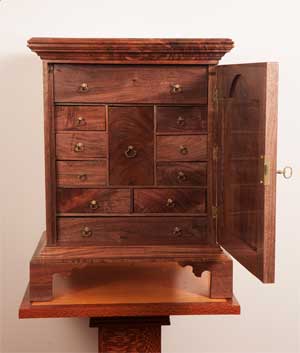
“When I learned how to use hand tools, it was way more fun, and more quiet.” Bill now uses a combination of hand tools and power tools in his projects — he still uses his planer — but, for the most part, “I now do all my dovetails by hand. I gave away all my dovetail jigs to charity. I’ll use a router if there’s a lot of dovetails, to knock out the waste quickly, but I generally like cutting them out with chisels.”
One of Bill’s favorite projects to make is a Massachusetts shelf clock. “I like it for several reasons: it looks good when you’re done; it’s not extremely difficult to make; and when you give it away, you touch it, because once a week you have to go over to it and wind it.”
“It’s one of the most fun things to make because people appreciate them,” said Bill who estimates he has given away 50 percent of what he’s made as gifts. Some pieces have also gone to charity, or to his personal collection. “I’ve never sold anything,” said Bill, a stockbroker by day. “If I was a professional woodworker, I would hate to sell something, because you’ll never see it again.”
One of the items he has made as a gift was a grandfather clock that was a retirement present for the chairman of his company. Five of the recipient’s favorite artists did paintings for the moon dial face, with the clock traveling around the country for six months so everyone could do their part.
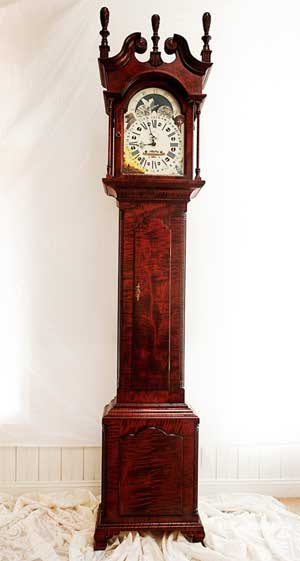
One of Bill’s finishing touches for the clock was its finials. “I had never made finials before. I turned them on the lathe, then carved them gouges to make them look like flames. I was pleased with how they came out because they were the first finials I ever made. I dyed them with a custom water-based dye I mix together, then put boiled linseed oil on and put them on the heating grate so they would dry.” When Bill came back a while later, the finials weren’t on the grate.
“About two weeks prior to this, we had gotten a boxer puppy named Brody. I found him with one finial in each paw and one in his mouth. He chewed the top part with the flames. It added texture.” Since the finials are 8′ 4″ up in the air on the finished clock, Bill left them with their newfound texture. “I tell people that seven artists participated in the clock: five artists did the painting, I built it, and the dog added texture and finish.”
Speaking of finishing, “When I first started woodworking, I hated the finishing process,” Bill said. “Once it’s made, it’s pretty — but now you’ve got to finish it.” His attitude has changed, so that, now, “I like watching it getting prettier and prettier” during the finishing process.
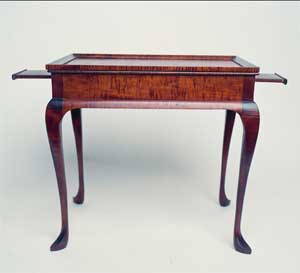
Bill mixes water-based dyes six or seven times until he gets the color he wants, then puts a coat of boiled linseed oil on to make the color stand out and bring out the grain and pattern in the wood. After letting the piece dry for five to seven days, he puts on coats of shellac. “Once I get the color I like, I stop. It’s usually four to six coats of shellac.”
For appearance’s sake, Bill’s favorite wood is tiger maple. “To me, it is the most beautiful wood, but it’s the hardest to work. It’s difficult to hand cut dovetails in tiger maple because the grain runs in different directions, and it’s a hard wood.”
He also works with walnut and mahogany, the woods that were popular in the 18th century in his area of Pennsylvania, as they were what was available. When it comes to walnut, as is the case with a large chest he made for his Utah home that lacks closet space, Bill will often put a veneer on it. “Straight-grained walnut is not very exciting, but if you put a veneer on the front of it, it really makes it pop,” he said.
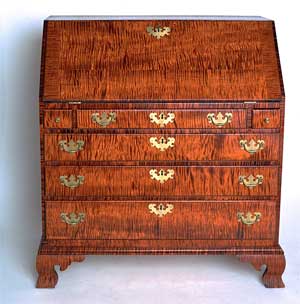
In his Pennsylvania home, Bill’s working on another project, which he calls “the biggest piece of furniture ever.” He has gutted the sheetrock down to bare studs in the former playroom on the second floor and worked with a contract to design a room that’s “100 percent cherry, no sheetrock, a lot of raised panels. To me, it’s going to be one large piece of furniture, because I’m going to make it as I would make any piece of furniture: with mortise-and-tenon joints, raised panels, dentil moldings.”
Bill’s attention to detail extends to his hardware choices as well, with his selections often being handmade. With his Chippendale slant-front desk, for example, “the hardware on that is close to $1,000. If you take the time to build it, you don’t want to put cheap hardware on it.”
Recently, Bill has been doing more inlay work, such as adding an inlay of bellflowers to a Chester County chest. “It takes a plain piece of furniture you put clothes in and makes it look so special. You take a piece of MDF and cut the shape you want, then move it from drawer to drawer. It’s done with routers, and drill bits on the end for the dots.”
“I like doing inlay because it’s meticulous,” Bill said. “I admire that type of work because it’s harder to make.”
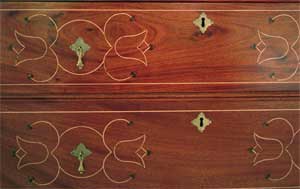
On a trip to Russia a year or so ago, Bill was impressed with 500-plus-year-old examples of marquetry in museums. “We’re beginners compared to what they did,” he said. “When you think you’re good, you can look at this old stuff and realize we’re just beginners.
“I feel like I’m still a beginner; there’s so much more to do and learn, and different items yet to be built. I like that the challenge never goes away. I wish I was retired so I could do it more often.”
